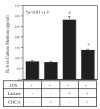Lactate boosts TLR4 signaling and NF-kappaB pathway-mediated gene transcription in macrophages via monocarboxylate transporters and MD-2 up-regulation
- PMID: 19201903
- PMCID: PMC2673542
- DOI: 10.4049/jimmunol.0802059
Lactate boosts TLR4 signaling and NF-kappaB pathway-mediated gene transcription in macrophages via monocarboxylate transporters and MD-2 up-regulation
Abstract
It has been shown that lactate induces insulin resistance. However, the underlying mechanisms have not been well understood. Based on our observation that lactate augments LPS-stimulated inflammatory gene expression, we proposed that lactate may enhance TLR4 signaling in macrophages, which has been shown to play an important role in insulin resistance in adipocytes. In this study, we demonstrated that lactate stimulated MD-2, a coreceptor for TLR4 signaling activation, NF-kappaB transcriptional activity, and the expression of inflammatory genes in human U937 histiocytes (resident macrophages). Similar enhancement of the inflammatory gene expression by lactate was also observed in human monocyte-derived macrophages. The essential role of MD-2 in lactate-augmented TLR4 signaling was confirmed by observation that the suppression of MD-2 expression by small interfering RNA led to significant inhibition of inflammatory gene expression. To further elucidate how lactate treatment enhances TLR4 activation, we showed that the augmentation of inflammatory gene expression by lactate was abrogated by antioxidant treatment, suggesting a critical role of reactive oxygen species in the enhancement of TLR4 activation by lactate. Finally, we showed that alpha-cyano-4-hydroxycinnamic acid, a classic inhibitor for monocarboxylate transporters, blocked lactate-augmented inflammatory gene expression and nuclear NF-kappaB activity, indicating that lactate transport through monocarboxylate transporters is required for lactate-enhanced TLR4 activation. Collectively, this study documents that lactate boosts TLR4 activation and NF-kappaB-dependent inflammatory gene expression via monocarboxylate transporters and MD-2 up-regulation.
Figures










Similar articles
-
The monocarboxylate transporter 4 is required for glycolytic reprogramming and inflammatory response in macrophages.J Biol Chem. 2015 Jan 2;290(1):46-55. doi: 10.1074/jbc.M114.603589. Epub 2014 Nov 18. J Biol Chem. 2015. PMID: 25406319 Free PMC article.
-
Ergosta-7, 9 (11), 22-trien-3β-ol Interferes with LPS Docking to LBP, CD14, and TLR4/MD-2 Co-Receptors to Attenuate the NF-κB Inflammatory Pathway In Vitro and Drosophila.Int J Mol Sci. 2021 Jun 17;22(12):6511. doi: 10.3390/ijms22126511. Int J Mol Sci. 2021. PMID: 34204506 Free PMC article.
-
Exogenous ceramide-1-phosphate reduces lipopolysaccharide (LPS)-mediated cytokine expression.J Biol Chem. 2011 Dec 30;286(52):44357-66. doi: 10.1074/jbc.M111.264010. Epub 2011 Nov 7. J Biol Chem. 2011. PMID: 22065582 Free PMC article.
-
Ciprofloxacin and levofloxacin attenuate microglia inflammatory response via TLR4/NF-kB pathway.J Neuroinflammation. 2019 Jul 18;16(1):148. doi: 10.1186/s12974-019-1538-9. J Neuroinflammation. 2019. PMID: 31319868 Free PMC article. Review.
-
Lactate transporters as therapeutic targets in cancer and inflammatory diseases.Expert Opin Ther Targets. 2018 Sep;22(9):735-743. doi: 10.1080/14728222.2018.1511706. Epub 2018 Sep 3. Expert Opin Ther Targets. 2018. PMID: 30106309 Review.
Cited by
-
Inflammatory mechanisms linking obesity and tendinopathy.J Orthop Translat. 2021 Dec 9;31:80-90. doi: 10.1016/j.jot.2021.10.003. eCollection 2021 Nov. J Orthop Translat. 2021. PMID: 34976728 Free PMC article. Review.
-
Inflammatory mediators in mastitis and lactation insufficiency.J Mammary Gland Biol Neoplasia. 2014 Jul;19(2):161-7. doi: 10.1007/s10911-014-9325-9. Epub 2014 Jun 25. J Mammary Gland Biol Neoplasia. 2014. PMID: 24961655 Review.
-
Pyruvate Dehydrogenase Kinase Inhibitor Dichloroacetate Improves Host Control of Salmonella enterica Serovar Typhimurium Infection in Human Macrophages.Front Immunol. 2021 Sep 6;12:739938. doi: 10.3389/fimmu.2021.739938. eCollection 2021. Front Immunol. 2021. PMID: 34552598 Free PMC article.
-
Inflammatory response of microglial BV-2 cells includes a glycolytic shift and is modulated by mitochondrial glucose-regulated protein 75/mortalin.FEBS Lett. 2013 Mar 18;587(6):756-62. doi: 10.1016/j.febslet.2013.01.067. Epub 2013 Feb 8. FEBS Lett. 2013. PMID: 23395614 Free PMC article.
-
The Values of PDK1 and LDH Levels in Patients with Sepsis and Septic Shock: A Prospective Observational Study.J Inflamm Res. 2024 Sep 30;17:6815-6826. doi: 10.2147/JIR.S477495. eCollection 2024. J Inflamm Res. 2024. PMID: 39372591 Free PMC article.
References
-
- DiGirolamo M, Newby FD, Lovejoy J. Lactate production in adipose tissue: a regulated function with extra-adipose implications. FASEB J. 1992;6:2405–2412. - PubMed
-
- Jensen JC, Buresh C, Jeffrey AN. Lactic acidosis increases tumor necrosis factor secretion and transcription in vitro. J. Surg. Res. 1990;49:350–353. - PubMed
-
- Beckert S, Farrahi F, Aslam R, Scheuenstuhl H, Konigsrainer A, Hussain Z, Hunt TK. Lactate stimulates endothelial cell migration. Wound Repair Regen. 2006;14:321–324. - PubMed
-
- Hiederman R, Zhang J, Kashke S. Short-chain carboxylic-acid-stimulated, PMN-mediated gingival inflammation. Crit. Rev. Oral Biol. Med. 1997;8:269–290. - PubMed
Publication types
MeSH terms
Substances
Grants and funding
LinkOut - more resources
Full Text Sources
Other Literature Sources

